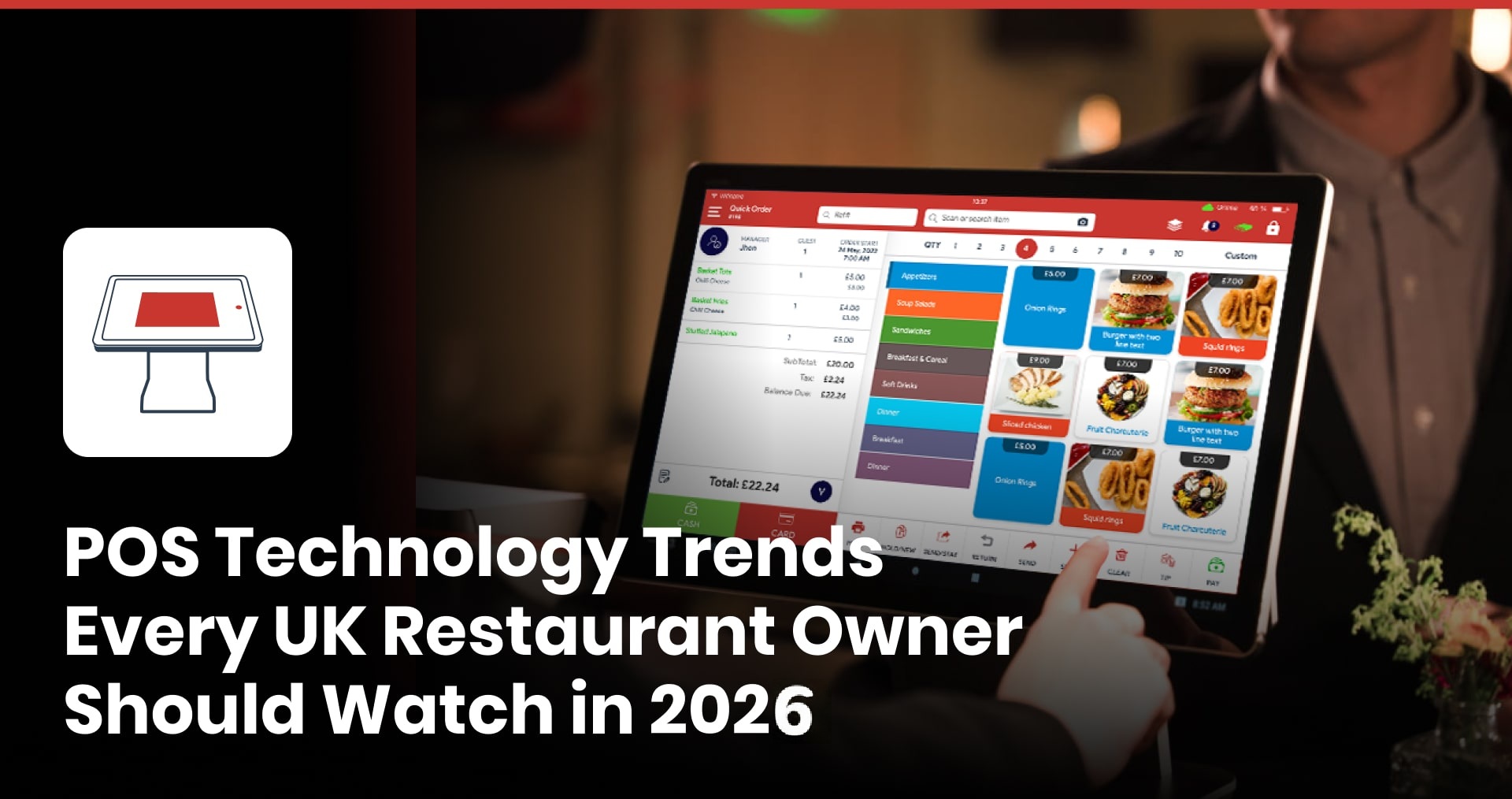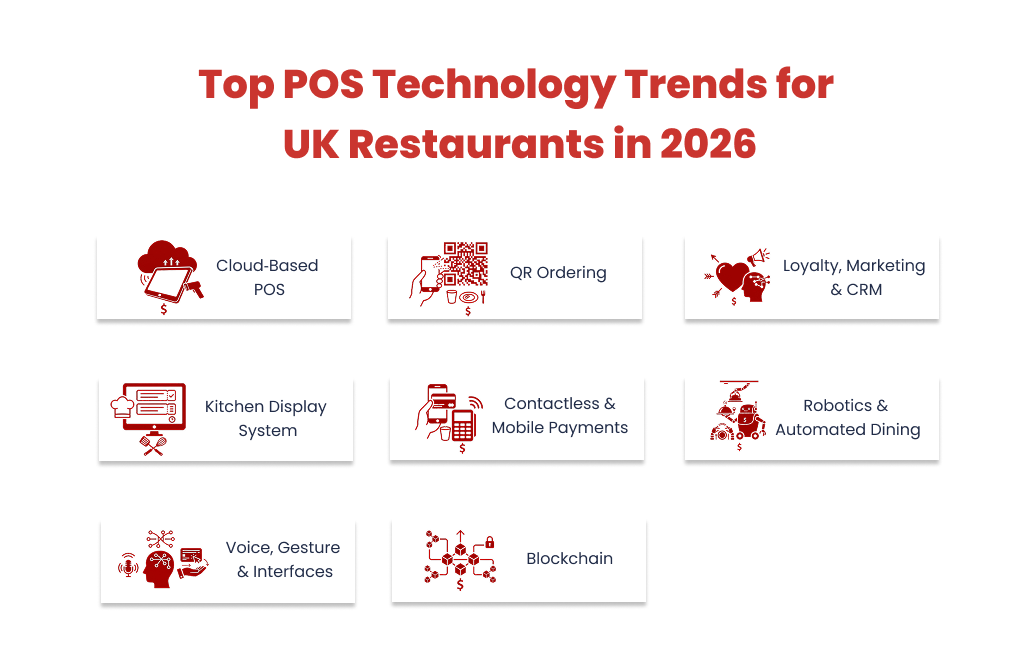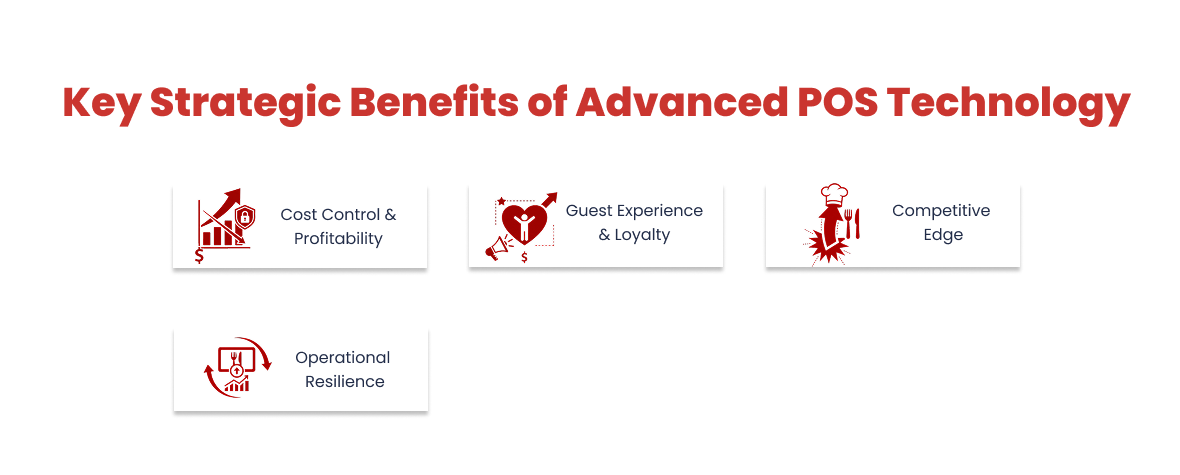POS Technology Trends Every UK Restaurant Owner Should Watch in 2026

Share This Story, Choose Your Platform!

Table of Content
- 1. Cloud‑Based POS: Access Anywhere
- 2. QR Ordering: Customer‑Centred Convenience
- 3. Integration with Loyalty, Marketing & CRM
- 4. Kitchen Display Systems (KDS) & Real‑Time Analytics
- 5. Contactless & Mobile Payments
- 6. Voice, Gesture & Emerging Interfaces
- 7. Blockchain & Enhanced Security
- 8. Robotics & Automated Dining
- Implementation Checklist for UK Restaurant Owners
- Strategic Advantages of Modern POS Technology
- Final Thoughts
- Frequently Asked Questions (FAQs)
- What is POS technology, and why is it critical for restaurants in 2026?
- What are the biggest POS technology trends UK restaurants should adopt in 2026?
- How does cloud-based POS benefit UK hospitality businesses?
- Why is QR code ordering still growing in popularity?
- How does POS help manage online ordering and delivery?
- What role does AI play in restaurant POS systems?
- How does integrated loyalty and marketing via POS drive repeat visits?
POS technology is the lifeline for modern restaurant operations in the fast-paced digital hospitality industry.
Smart restaurant owners in the UK are using advanced point-of-sale (POS) systems for purposes beyond simply taking orders.
These systems serve as an intelligent command center that seamlessly integrates a wide range of features, including workforce management, real-time analytics, mobile ordering, payments, inventory, customer loyalty, and even sustainability tracking.
To stay competitive, UK hospitality businesses need to implement creative strategies in response to tighter margins, staff shortages, and rising customer expectations.
Smart cloud-based POS solutions are becoming increasingly essential.
These platforms empower restaurant owners and operators to streamline daily operations, enhance guest experiences, and make data-driven decisions that directly impact profitability.
This blog discusses revolutionary POS technology trends that will influence UK restaurants in 2026 and beyond.
To succeed in the digitally driven, guest-centric hospitality industry, it is essential to understand and implement these trends, whether you operate a quick-service restaurant, a fine dining establishment, or a high street venue.

1. Cloud‑Based POS: Access Anywhere
Cloud-based point-of-sale (POS) systems have emerged as the new standard in the UK hospitality industry in 2026, from standalone cafés in Brighton to multi-location pub chains in Manchester and London.
Unlike traditional systems, cloud POS operates on the internet and synchronizes data in real time across all connected devices.
From a laptop at home or a smartphone while travelling, these restaurant managers and owners can track sales, update menus, track inventory, and even run reports.
Why It Matters:
- Simple multi-site control: Control multiple locations with ease from a single dashboard.
- Automated updates: Eliminate IT hassles and remove the need for manual software updates.
- Integrated resilience: The system continues to operate offline during an internet outage and automatically syncs data once the connection is restored.
UK Impact:
Cloud POS offers operational consistency and flexibility to coffee franchises, pub chains, and boutique hotel restaurants throughout the United Kingdom.
The ability to manage sites remotely, whether you’re in Exeter or Edinburgh, is revolutionary, as staff shortages are a problem in the industry.
2. QR Ordering: Customer‑Centred Convenience
UK restaurants have seen significant shifts in customer interaction, and POS systems are adapting to these changes.
By 2026, a growing shift toward self-service kiosks, QR code menus, and mobile ordering is expected, all designed to give customers greater control over their dining experience.
QR-code ordering continues to grow fast (30% annual growth from 2019–22), and NFC is predicted to handle 50% of contactless transactions by 2026, demonstrating diners’ growing preference for self-service mobile ordering.
A pandemic necessity turned into a consumer expectation.
Once a novelty, QR code ordering has become commonplace, enabling customers to browse menus, place orders, and make payments all through their smartphones.
At the same time, self-service kiosks are starting to appear frequently in quick-service restaurants and even casual bars, providing accurate, personalised, and quick ordering without the need for a line.
Why It Matters:
- Faster service and higher turnover: Streamlines the guest journey from order to payment.
- Reduced pressure on staff: Frees up front-of-house teams for other tasks while empowering guests to take the lead.
- Digital-first appeal: Perfectly aligns with Gen Z and millennials who prefer using their phones over flagging down waitstaff.
UK Impact:
To remain competitive, UK establishments are adopting mobile and contactless ordering, from independent cafés in Bristol to the busy food markets in London.
These devices are no longer optional; they are essential for meeting the expectations of a tech-savvy audience, enhancing operational efficiency, and delivering seamless experiences.
3. Integration with Loyalty, Marketing & CRM
In the competitive hospitality industry, retaining customers is far more valuable than simply attracting new ones.
Next-generation POS platforms, like Quantic POS, are evolving into customer relationship powerhouses, seamlessly integrating with CRM tools, loyalty programs, voucher systems, and targeted marketing campaigns.
By centralizing control over promotions, customer insights, and engagement strategies, all from the same dashboard that manages daily sales, Quantic POS eliminates the need for multiple third-party apps and fragmented systems.
This unified approach enables UK venues to deliver personalized experiences, reward loyal patrons, and strengthen customer relationships, all while streamlining operations and maximizing revenue.
Why It Matters:
- Strengthens Loyalty: Integrated loyalty programs and vouchers reward increase repeat customers and long-term engagement.
- Simplifies Engagement: Centralized customer data and marketing tools make it easy to run targeted campaigns.
- Boosts Revenue: Personalized offers and promotions increase spend per visit and drive repeat business.
UK Impact:
With platforms using deep customer insights to optimise performance, independent UK operators can now compete with their complex strategies.
A small chain in Glasgow or a neighbourhood café in Sheffield can build lasting relationships with customers and increase footfall.
By integrating CRM and loyalty features into their point-of-sale system, they can also drive repeat business without the need for costly enterprise-level marketing.
4. Kitchen Display Systems (KDS) & Real‑Time Analytics
Kitchen Display Systems (KDS) are revolutionizing the way restaurants manage their back-of-house operations.
By replacing traditional paper tickets with dynamic, real-time order displays, Quantic POS’s KDS ensures orders are organized, visible, and actionable, reducing errors and speeding up service.
Seamlessly integrated with a modern POS platform, these intelligent screens give kitchen teams precise control over workflow, order timing, and prioritization.
Beyond just visualizing orders, Quantic POS leverages real-time analytics to provide actionable insights across every aspect of kitchen management.
From refining menu offerings to streamlining prep stations and optimizing staff performance, these analytics empower operators to make data-driven decisions that enhance efficiency, consistency, and customer satisfaction.
Why It Matters:
- Reduce Errors: Eliminating handwritten tickets minimizes mistakes and ensures orders are prepared correctly.
- Boost Speed: Real-time order tracking and intelligent workflow prioritization keep the kitchen moving smoothly, even during peak hours.
- Enhance Decision-Making: Data-driven insights help operators identify bottlenecks, adjust menu offerings, and optimize staffing.
UK Impact:
Adopting KDS and integrated analytics results in faster turnaround, better food consistency, and fewer mistakes at the pass for busy pubs in London, high-street fast-casuals in Birmingham, and fine-dining kitchens in Edinburgh.
Building a quicker, smarter, and more effective kitchen is more important than simply going digital.
5. Contactless & Mobile Payments
Contactless payments are now the standard in the UK rather than just the norm.
In the UK, diners expect quick, safe, and easy payment options everywhere they go, as contactless methods now account for over 60% of in-person transactions.
This implies that POS systems for restaurants need to facilitate a smooth checkout process while supporting mobile tipping, NFC-enabled cards, Apple Pay, and Google Pay.
In 2024, 94.6% of in-store card transactions were contactless, with each UK consumer averaging 236 taps annually, spending around £3,803 per year via contactless payments, per Barclays’ latest report.
Quick taps, digital receipts that happen automatically, and even personalised tip prompts are all made possible by modern payment terminals that are integrated with your POS system.
These features improve employee morale and guest satisfaction.
Key Takeaways:
- Speed & convenience: Tap-to-pay is considered standard by customers, particularly in casual dining and quick-service environments.
- Boosted tipping culture: At the point of payment, on-screen tip options promote generosity and boost team spirit.
- Sustainability in action: Digital receipts help businesses achieve their eco-friendly objectives and reduce paper waste.
UK Impact:
Mobile and contactless payments are now an essential part of everyday operations, whether you’re a street food truck in Camden or a pub in Liverpool.
However, protecting access to cash has become a growing topic of legal discussion in the UK, particularly concerning older and vulnerable populations.
To strike a balance between innovation and inclusivity, operators should ensure that at least one traditional payment option remains available.
6. Voice, Gesture & Emerging Interfaces
POS technology has begun to adopt voice recognition, gesture control, and other cutting-edge interfaces that were previously only found in science fiction as the hospitality sector continues its digital transformation.
Although still in the early stages of adoption, these innovations are already making an impact in high-volume environments such as quick-service counters, cocktail bars, and busy kitchens.
Without requiring face-to-face interaction, voice commands can streamline order entry, bill splitting, and service coordination.
Similarly, gesture-based controls provide hygienic shortcuts, ideal for environments where cleanliness and speed are essential.
Why It Matters:
- Voice-powered efficiency: Keeps workflow quick and clean by allowing bartenders or chefs to update orders or check tabs hands-free.
- Gesture Shortcuts: Can be used to initiate pre-programmed actions in environments like the pass or bar, or to expedite POS navigation.
- Future-focused flexibility: As IoT devices and AI voice assistants become more popular, visitors may soon be able to engage with POS via voice-activated kiosks or smart tables.
UK Impact:
Although still in their early years, these technologies are being tested in innovative environments, particularly in Manchester and London.
Operators that are looking ahead and investigating these devices now will be in a better position to adjust as touch-free interactions gain popularity, particularly in high-end or high-volume concepts.
7. Blockchain & Enhanced Security
For UK hospitality operators, security has become a top priority due to the increase in cybercrime and data breaches.
Blockchain is a decentralised, cryptographically secure ledger that is currently being studied in point-of-sale (POS) ecosystems to increase transparency and safeguard private data.
Blockchain ensures a secure and transparent way to audit supply chains, verify payments, and enhance data integrity by recording transactions on an immutable ledger, all without compromising usability or speed.
Why It Matters:
- Secure transactions: Fraud is much more difficult because payments are validated across decentralised nodes.
- Supplier traceability: By storing provenance information on the blockchain, customers can feel more confident about ethical standards and sourcing.
- Reduced risk of tampering: Immutable records protect high-volume, multi-site operators by preventing unauthorized changes.
UK Impact:
Blockchain is still a relatively new technology, but its use in hospitality point-of-sale (POS) is expanding, particularly among larger chains, upscale restaurants, and companies with intricate procurement requirements.
In the years to come, its capacity to improve consumer trust and compliance will lead to wider adoption.
8. Robotics & Automated Dining
Although it may seem futuristic, robotic automation is already being implemented in parts of the UK hospitality industry, with point-of-sale (POS) systems advancing to support it.
From the AI-powered voice assistant at a Popeyes UK drive-thru to the robotic meat slicer at German Doner Kebab, smart automation is allowing operators to expedite service, lower costs, and create a memorable customer experience.
Robotic waitstaff has begun to be used for basic table service even in casual dining establishments like Bella Italia and Ping Pong; these servers are often linked to mobile ordering and point-of-sale systems.
Why It Matters:
- Labor support: Robots ensure consistent service while helping to cover staffing shortages.
- AI-powered drive-thrus: Quicker, more precise ordering in situations with high demand.
- POS integration: Order flows and kitchen tickets are synchronized with automation systems.
UK Impact:
Robotic automation is progressing beyond novelty, despite still being relatively specialized, particularly in QSRs, food courts in shopping centers, and urban innovation hubs.
Food preparation, serving, and delivery in the UK will increasingly involve robot-human collaboration as costs come down and point-of-sale systems become more modular.
1. Core Tech Foundations
Adopt a cloud‑based POS system
Ideal for owners on the go, it enables them to monitor multiple sites in real-time, manage menus remotely, and access live sales.
Consolidate with an all‑in‑one POS
To reduce complexity and increase efficiency, it combines ordering, inventory, loyalty, payments, and reporting into a single smart platform.
Enable contactless and mobile payments
Accept tap-to-pay cards, Google Pay, and Apple Pay. Customers in the UK now consider this to be the norm.
Ensure inclusive payment options
Digital payments dominate, but always provide cash options for all visitors to remain compliant.
2. Revenue, Sales & Service Enhancements
Implement in-house online ordering
You can save money on third-party commissions and maintain direct client relationships by utilizing your own branded platform.
Use QR code and table ordering
Expedite service, ease employee strain, and facilitate contactless, frictionless ordering, particularly useful in crowded cafés and bars.
Deploy AI for sales forecasting & smart pricing
Forecast demand, control inventory, and instantly modify prices in response to events, seasons, and trends.
Install digital KDS and tap into real-time analytics
Make data-driven decisions to minimize waste and delays, eliminate paper tickets, and monitor kitchen performance in real time.
3. Customer Loyalty & Innovation
Integrate loyalty, CRM & marketing tools
Convert one-time diners into dedicated regulars by automating email campaigns and creating customized promotions.
Explore emerging tech (voice, gesture, robotics)
Voice-activated point-of-sale systems or service robots that enhance speed and experience, particularly in high-volume or creative concepts.
Strategic Advantages of Modern POS Technology
In the UK’s rapidly changing hospitality industry, upgrading your point-of-sale system is a strategic decision that supports profitability, resilience, and long-term growth.
It’s not just about faster table service or easier transactions.

a) Cost Control & Profitability
Smart POS platforms offer inventory management tools to minimize waste, automation to reduce labor expenses, and dynamic pricing engines that adjust menu prices based on demand and real-time cost data
improved profitability, lower overhead, and tighter margins without compromising service quality.
b) Guest Experience & Loyalty
Platforms that facilitate online ordering, loyalty apps, and customized promotions are now an essential component of the customer experience, as more than 70% of UK consumers anticipate digitally first dining experiences.
In addition to being practical, this technology increases repeat business, fosters brand trust, and converts visitors into brand ambassadors.
c) Competitive Edge
Tech-forward restaurants are setting new standards.
To stay relevant, visible, and competitive in a crowded market, independent operators must keep up with the latest advancements in POS, ordering, and delivery technology.
d) Operational Resilience
Orders synchronize as soon as the connection is restored, enabling operators to remain online even during local outages with cloud-based point-of-sale systems.
Offline modes and built-in redundancies result in fewer interruptions, no lost sales, and increased peace of mind.